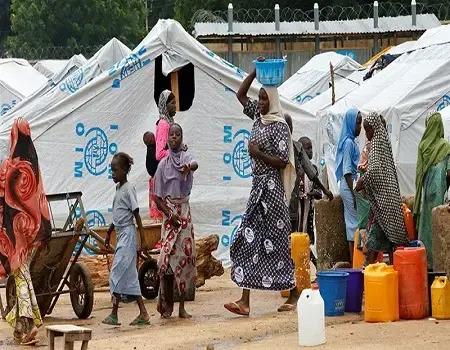The United Nations UN Migration Agency, the International Organisation for Migration (IOM), said it is partnering with the Federal Government and some states to provide houses for Internally Displaced Persons (IDPs) in the North East, a move that would see them leaving transitional camps for more permanent abodes.
Under the initiative tagged “Home after Crisis,” IOM said the zone is its immediate focus, while in the future it hopes to expand the scope of the initiative to other parts of the country.
IOM’s Chief of Mission to Nigeria, Mr Laurent Boeck, disclosed this at a news conference in Abuja on Wednesday.
“We are launching a concept, a change of mindset. To change the way humanitarian actors work to move out of emergency shelter or transitional housing to something more permanent, using the beneficiaries, he said.
READ ALSO: Governor Radda Allocates Land for Construction of 500 Houses in Katsina
According to him, IOM and her partners would train the IDPs to build their own homes, using materials that are largely locally sourced, with the aim of moving them from dependency on humanitarian assistance to self-sufficiency.
He also added that IOM has settled over 9, 000 people who were formerly IDPs in some states in the North East.
Consequently, the UN agency said its Housing Design Competition Awards Ceremony, which would take place on Friday in Abuja, had brought together designers, architects, and engineers capable of fostering innovation and providing a wide array of options for the future.
“With funding from the National Humanitarian Fund (NHF), IOM organised the inaugural housing design competition, titled ‘Nigeria: Home After Crisis.’ The primary focus of this competition was to engage domestic and international design communities in developing low-cost, incremental, and modular housing solutions for displaced people and vulnerable families in rural areas of north-east Nigeria.
“We are delighted to share that the competition garnered an overwhelming response, with 250+ design proposals received from 1600+ designers, architects, and engineers across 100+ countries. Notably, 23% of participants were from Nigeria, and the winner of the $5000 award is also a Nigerian,” IOM said.
De Boeck said since 2015, the northeast of Nigeria has faced escalating violence, leading to an unprecedented housing emergency.
“As of 2023, an estimated 3.5 million people had lost their homes or lived in precarious conditions. Nigeria currently experiences an acute housing deficit, estimated at around 23 million, requiring the construction of one million housing units annually for the next 20 years.
“At IOM, we commit to supporting the government and the people of Nigeria to increase the current production rate of housing construction with the private sector. To address this, IOM Nigeria is actively working to overcome the shelter emergency with a durable housing strategy. The objective is to move beyond merely providing housing units and embrace the concept of providing a home.
“The 2023 ‘Home After Crisis’ design competition, funded by the Nigerian Humanitarian Fund NHF, is part of this effort.
“The housing competition targets the housing challenges linked to Nigeria’s rapidly growing population. They aim to provide access to affordable housing, built with the goal of delivering climate-proof housing with local materials.
READ ALSO: Governor Radda Allocates Land for Construction of 500 Houses in Katsina
“The housing competition paves the way to engage the world in addressing these challenges. They provide a route towards integrating development programmes with the humanitarian response. Above all, it is crucial that it ensures that no one is left behind as we transition away from crises where safety and conditions prevail.
“It provides those affected by displacement with a home that is integrated with their natural environment and the stepping stones to engage with local and national development plans. It respects culture and the social fabric, which makes society a safe heaven, where communities live peacefully together, linking generations and persons interacting with each other. It is not just a roof, but it becomes an integrated home within the ancestral society, he added.



